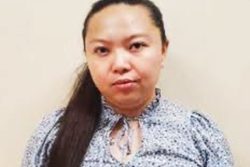The demarcation of Sawariwau’s titled land has been finally been completed by the Guyana Lands and Surveys Commission (GLSC).
Sawariwau, (Upper Takutu/Upper Essequibo) had been granted title to their existing tract of land since 1991 with a description of the boundaries in words but without a physical survey and demarcation.
A release from the Justice Institute of Guyana said that at a meeting held earlier this year in June, Toshao Gregory Thomas, Deputy Toshao Tony Andrew of Sawariwau and Melinda Janki of the Justice Institute had asked President Donald Ramotar to intervene to speed up the process for the land to be demarcated.
The completion of the survey by the GLSC means that Sawariwau’s boundaries are accurately marked on a map for the first time. With the help of this map, Sawariwau can use the Amerindian Act 2006, to claim the lands they have traditionally occupied and used but are not within the boundaries of the description of the titled area.
The Justice Institute explained that land issues in the south Rupununi were far from straightforward. It said that at one time the Rupununi Development Company had held thousands of square miles of land south of the Kanakus under a lease granted by the British Colonial Government.
Since the 1930s the Rupununi Development Company has been releasing land back to the State. Some of this land has subsequently been occupied by and titled to Amerindian communities. Some Wapichan communities also occupy and use what was formerly traditional Atorad and Taruma lands.
According to Gregory Thomas, the Toshao of Sawariwau, on a recent visit to Georgetown, “I am very happy that our land demarcation is completed after we have been waiting a long time. Now we are looking forward to working with the Minister [of Amerindian Affairs] to settle our outstanding land claim for the extension of our land.”
In many communities the demarcation of Amerindian land is a controversial exercise because of confusion over names and places. However in the case of Sawariwau, the Toshao explained that, “Eleven persons from our community went with the surveyors to show them the exact places that we have named and we know on the ground.”
The release said that this cooperation between the community and the Guyana Lands and Surveys Commission has resulted in agreement on the boundaries of the titled area.
The GLSC was also able to give Sawariwau a draft map showing the agreed boundaries before the surveyors left the community.
The Justice Institute has been providing Sawariwau with legal advice on their land rights since December 2011. With the legal assistance, the community has now made their claim under the Amerindian Act 2006 for land which they have traditionally occupied and used but which was left out of the description of their titled area.
According to the release, Janki, Executive Director of the Justice Institute said, “The next step is for the Minister of Amerindian Affairs to deal with Sawariwau’s claim for the land which they have traditionally occupied and used and which lies outside of their titled area. The Amerindian Act 2006 sets time limits which are enforceable in the court. So there must not be any further delay.”
The extension requested by Sawariwau under the Amerindian Act 2006, is for land originally claimed by their fore parents in the Amerindian Lands Commission report of 1969.
At the time of the Amerindian Lands Commission, the Wapichan people had requested one title for each Wapichan village rather than a single title to cover the land then occupied and used by all the Wapichan people. The Amerindian Act 2006 (like its predecessor the Amerindian Act Cap 29:01) had put this request into law, the release added.








